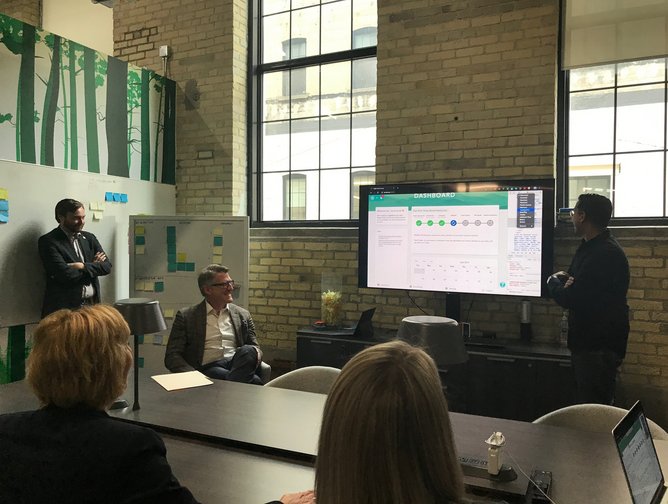Digital transformation of operations and customer journeys at Ontario Workplace Safety and Insurance
In Ontario, Canada, workers benefit from legislation compelling their employers to provide workplace insurance. This strategy necessitates a provider for that cover and Ontario’s Workplace Safety and Insurance Board (WSIB) is that very organisation. While many companies view digital transformation as a means to keep up-to-date with the times or gain a measure against the competition, such compulsions are not so clear for state-mandated entities; if the organisation is essential, one might wonder why that organisation would prioritise exhaustive modernisation and the heavy investment and strategic challenges of shifting operations to digitised solutions that it entails. Samantha Liscio, Chief Technology and Innovation Officer at WSIB, dismisses such notions: the focus, she says, has to be on making the customer experience seamless, straightforward, and easy, irrespective of whether employers have the option to change insurer. “Our CEO affirms that our goal here is to be the insurer of choice,” she says. “Even as a monopoly, if our customer had a choice they should pick us, and he's very vocal about that.”
This obligation is driven by the services and solutions that customers have come to expect from the modern world, where vital information and operations can be accessed and actioned through apps that define and enable sleek, optimised customer journeys. “We still have competition on customer expectations, and we feel that very keenly these days when people can go online and bank or purchase airline tickets with one click,” explains Liscio. “It makes an imperative for us to be able to provide services like that to them, because when our clients come to us they're injured or they're ill and they expect that the great work that we do to help them get better and return to work isn't overshadowed by how difficult it is to deal with us. They don't want to be worrying about mailing or faxing information to us, they don't want to have to call to figure out their claim status, and they want the WSIB to be easy and straightforward and available. That really is what's driving digital transformation for us.”
With this focus on the customer, WSIB has identified the processes which define the customer journey and performed a series of ethnographic studies into the needs and expectations of its customer base. By then taking staff through each facet of that journey, the areas of convolution and friction become clear. Addressing these areas of frustration, Liscio says, will enable the digital transformation to precipitate the correct changes for the organisation as a whole. “Getting staff to think from an outside in kind of focus, and getting that customer experience right, drives other values too. We track public value as a key measure and part of our strategic metrics reporting, and if we get the customer piece right, our public value and trust measures change for the better as well. With a clear focus on what our customers want, IT can foster discussions around the art of the possible in using digital tools to enable transformation. IT can show the business what modern technology and modern software can bring in terms of enablement and meeting those customer needs, effectively orchestrating and architecting for the future in a scalable, efficient, and sustainable way.”
While Liscio believes that some traditional access channels will remain in place to serve the less digitally-enabled, removing reliance on paper is a fundamental piece of the transformation. Claims related documents can now be uploaded directly from a laptop or mobile phone and delivered to the organisation digitally, significantly decreasing the lead times for postage and processing of faxes that traditionally hinder the expedition of claims processes. This customer-facing element permeates through the organisation as part of what Liscio calls WSIB’s biggest transformation endeavour in its 105-year history: the core services modernisation programme. “It's essentially doing three things,” she explains. “It's getting rid of paper and becoming digital at source, because if you're handling digital information it fundamentally changes the business processes, rationalising those business processes in line with customer journeys and then finally deploying the enabling technology using agile methods that can be sustainable in the long term. Doing all three of those together is key so this isn't just a technology project, even though a big component of that is replacing and upgrading our core system of record.”
This is where key partner Guidewire comes in, providing a suite of digitally-enabled insurance tools to facilitate rapid claims registration, administration and return-to-work processes. “A ‘quick win’ for us has been the digital document upload tool that we launched last year, and its connectivity to Guidewire,” enthuses Liscio, adding that the organisation’s time to market has been cut drastically through using the digital factory to drive development. “In the past, it took years to launch WSIB products, but this one was 16 weeks from inception to launch. In 2018, we received more than 2.3mn pieces of paper either by mail or by fax and we're cutting a lot of that through the digital upload tool; it now has more daily uploads than the total documents we receive in paper. They come in and they go into the Guidewire back-end system instantaneously. It also removes some of the call volume that we have from people asking if we have received their postal or fax documents, removing all of the barriers to good and fast customer service.”
To remove the barriers to its own transformational success, WSIB has also partnered with IT and business services consultancy Avenai to introduce a new, digitally-empowered organisational framework. “Previously there were silos of IT operations and solutions delivery; it didn't work well together. When a major project was finished and the development work was done, it kind of got thrown over the fence to operations to manage and maintain it. If there were defects that needed to be worked through with problem management, that work was difficult to assign and there was finger pointing between operations and delivery as to who should do it,” Liscio explains. “Avenai helped us do a current state assessment of how our legacy model was impeding our progress and then suggested an industry standard IT operating model that was much more client focused, with delivery verticals leveraging agile and DevOps methods and supported by horizontal IT shared services functions. We've moved our entire 300+ person IT organisation into that new functional model, and have started to change behaviours at the leadership level by agreeing on a set of values that we aspire to. At its heart, it’s about being customer focused, collaborative, demonstrating clear value to the business and moving from a project to a product focus. Avenai was very helpful in helping us help shift the organisational culture, applying specific behavioural performance objectives, and helping us bring the necessary leadership, values, and culture piece into the change management approach during the deployment of the new model.”
Change management, the Everest of all digital transformations, has thus been enabled by this structural revolution to WSIB’s IT operations and the associated change in culture across the IT organisation. The success of its new digital products, and the ability to automate repetitive tasks and expand the capacity for employees’ additional value-added activities, is facilitated by this newly-enabled readiness. An example that Liscio offers regarding automation is in the straight-through processing of medical expenses claims that it enables. “More than 70% of the claims that we have involve simple reimbursement for medical costs. Those can be processed automatically in the Guidewire solution, based on WSIB business rules, and we can take advantage of the automation potential within the software itself. This straight-through processing means that claims processing times are dramatically improved and staff with high skills and expertise can spend their valuable time on the complex claims that require human decisions.” As a result, a claims process that could have taken a full payment cycle to deliver has become instantaneous, and the benefit for customers speaks for itself.
In the age of digital transformation, customer centricity and operational preparedness are characteristics that separate the winners from the chasers, and this is no less certain for companies whose offering is mandated by local authorities. These qualities resonate through the entirety of Liscio’s strategic endeavours. “For digital transformation to succeed, IT can't be the order taker to the business to execute on individual priorities, it needs to demonstrate clear value that's aligned to the customer, it needs to do these things while keeping the engines running and the plumbing working, all in a safe and secure and sustainable way,” she asserts. “It's about looking at things foundationally, assessing the key pieces that we need to have in place to truly transform how we do our business, and leveraging the expertise of key partners that will help us get that right.”







